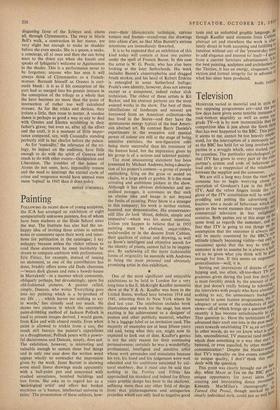Painting
For-Lowista its recent show of young sculptors, the ICA has arranged an exhibition of eight comparatively unknown painters, five of whom have been students at the Slade School since the war. The Institute has also had the un- happy idea of inviting these artists to submit notes or comments upon their work and inten- tions for publication in the catalogue; I say Unhappy because unless the visitor refuses to read these statements he must inevitably be drawn to compare ambition with performance. Eric Finlay, for example, instead of issuing no statement, as one of the contributors has done, brashly offers some old Dada chestnuts —'wears dark glasses and runs a bawdy-house in Marrakesh'—in a manner which comments, obliquely perhaps, but devastatingly, upon his old-fashioned pictures. A painter called, simply, Duncan, who writes 'Everything goes into my painting which is a by-product of my life . . . which leaves me nothing to say in words,' has already said too much. He shows two pictures in which the automatic paint-dribbling method of Jackson Pollock is used to present images derived, I would guess, from Klee and with absurd results. Even when paint is allowed to trickle from a can, the result still betrays the painter's capabilities as a draughtsman; Pollock pours with a power- ful decisiveness and Duncan, simply, does not. The exhibition, however, is interesting and valuable enough to sustain these bad things and in only one case does the written word appear wholly to contradict the impression given by the work. Janet Barrett is showing some small linear drawings made apparently with a ball-point pen and concerned with crashed aeroplanes, bombed buildings and tree forms. Shc asks us to regard her as a 'sociological artist' and offers her broken machines as 'a human, intellectual universe in ruins.' The presentation of these subjects, how-
ever—their idioiyncratic technique, curious texture and frames—transforms the drawings into objets d'art, so that Miss Barrett's serious intentions are immediately thwarted.
It is to be expected that an exhibition of this kind today will contain at least one painter under the spell of Francis Bacon. In this case the artist is W. G. Poole, who has also been looking at the later Sutherlands. His work includes Bacon's claustrophobia and dragged brush strokes, and his head of Robert Erskine is entangled in some Sutherland leafage; Poole's own identity, however, does not emerge except as a competent, indeed rather slick technician. The oldest of these artists is Kit Barker, and his abstract pictures are the most assured works in the show. The best of them '(distillations of landscape and season) are borrowed from an American collection—he has lived in the States—and they have the spontaneous energy typical of the best Ameri- can abstract art. By contrast Barry Daniels's experiments in the evocative and musical power of colour are still at the stage of being tentative exercises, the non-figurative orfes being more successful than his treatment bf the human head, but the impression given by his group is of a serious and talented painter.
The most unassuming statement has been presented by Michael Andrews, being a descrip- tion of his picture's content—a group of people sunbathing, lying on the grass or seated on chairs, in a large park or garden. It is the most arresting and ambitious picture in the show. Although it has obvious deficiencies and un- realised passages, it convinces us that such an elusive idea and image is not beyond the limits of painting. Peter Snow is a stranger in this company; his work is neither violent, haunted, nor demonstrative. His conservatory still lifes do look 'direct, definite, simple and impassive'—which was his stated intention. Unless you happen to believe that in 1955 painting must be abstract, angst-ridden, social-realist or in the descent from Cubism, their qualities of colour and drawing, as well as Snow's intelligent and objective search for the identity of plants, cannot fail to be impres- sive. By eschewing all the more fashionable forms of originality he succeeds with Andrews in being the most personal and obviously promising artist in this exhibition.
One of the most significant and enjoyable exhibitions to be held in London for a very long time is the E. McKnight Kauffer memorial show at the V & A. Kauffer was born in the United States, worked here between 1914 and 1941, returning then to New York where he died last year. The exhibition includes book illustrations and work for the stage, but most exciting is his achievement as a designer of posters and other publicity material, whether it be a luggage label or an invitation card. The majority of examples are at least fifteen year old add, being what they are, might now he expected to look out of date. Kauffer's genius is not the only reason for their continuing persuasiveness; certainly he was a wonderfully professional, intelligent and sensitive artist whose work persuades and stimulates because his eye, his hand and his judgement were well educated and his ambitions untainted by cul- tural snobbery. But it must also be said that nothing in the Forties and Fifties has approached his standard and indeed for fifteen years graphic design has been in the shallows, suffering more than any other field of design from that picturesqueness and antiquarian prejudice which can orlly lead to negative good
taste and an enfeebled graphic language. A!' though Kauffer used elements from Cub's" abstract art and elsewhere the work is al's!): lutely direct in both accepting and fulfilling n' function without any of the 'present-day trend to add elegance and interest to' itself—I clue, from a current furniture advertisement. Ik`', the best painting, sculpture and architecture 0' the Thirties, it has an energy, eloquence, al; viction and formal integrity far in advance of what has since been produced.
BASIL TAO


































 Previous page
Previous page